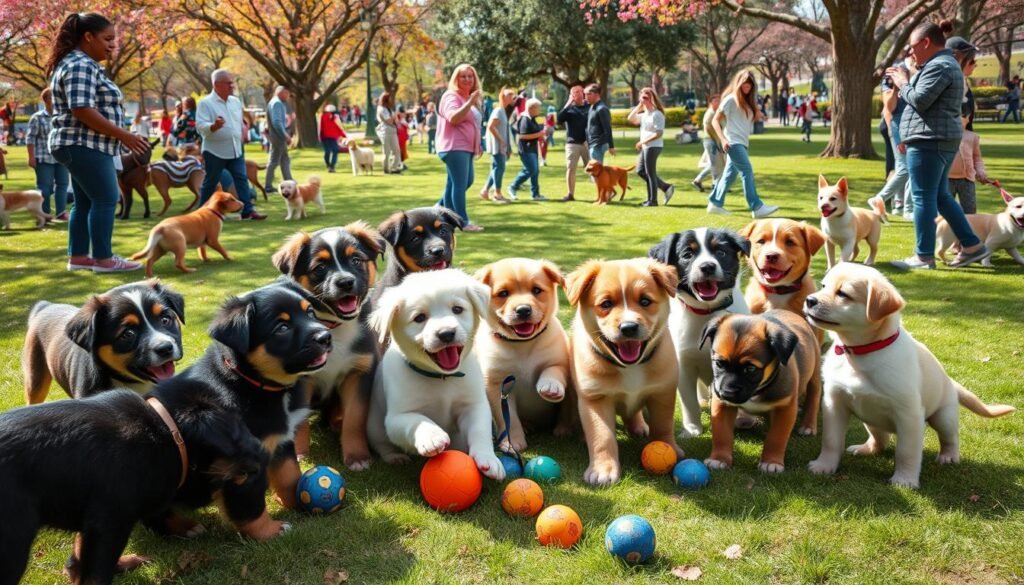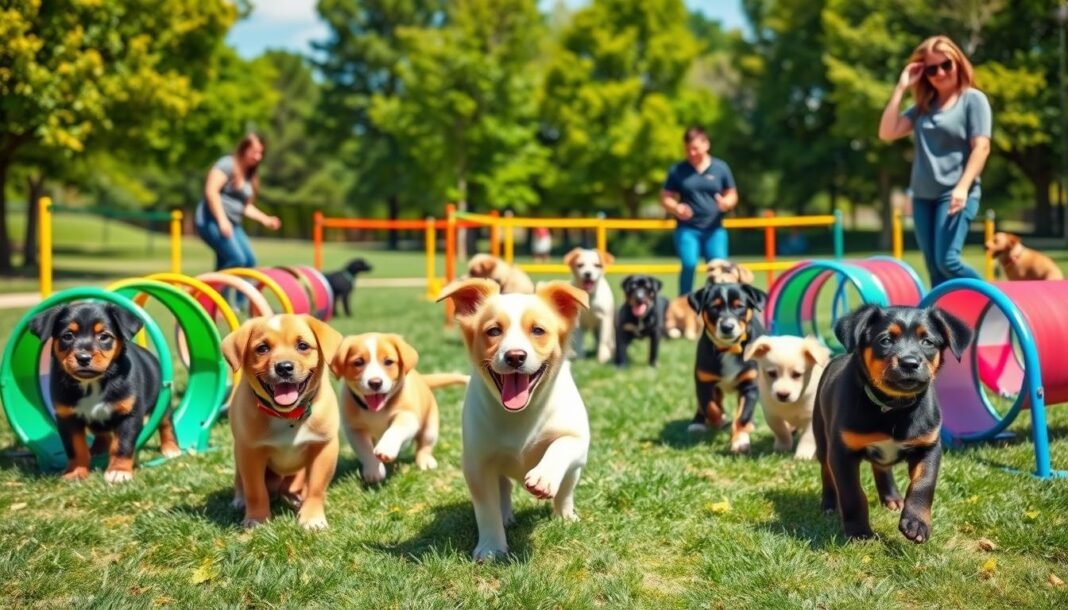Welcome to ABCs Puppy Zs, a place where training your puppy is a fun adventure. Training early helps create a strong bond between you and your puppy. We use fun training techniques that keep your puppy engaged and eager to learn.
Techniques like positive reinforcement and clicker training make training enjoyable rather than a chore. It’s all about turning training into a great experience. It helps you and your puppy understand each other better. So, get ready for an exciting journey of growth with your puppy!
Key Takeaways
- The ABCs Puppy Zs approach promotes engaging and enjoyable puppy training.
- Early training strengthens the bond between owner and puppy.
- Positive reinforcement is an effective technique in dog training.
- Clicker training helps puppies understand commands through positive feedback.
- Puppy training should be viewed as a fun activity, not a chore.
Understanding Puppy Behavior
Learning about puppy behavior helps train them better and strengthen your bond. It’s about understanding their ways of communicating. This includes their body language, sounds, and energy. Knowing this lets you meet their needs and understand their feelings better.
How Puppies Communicate
Puppies use different signs to show how they feel, what they want, or if something’s wrong. A wagging tail usually means they’re happy, but a tucked tail could mean they’re scared. Spotting these signs can make training and interaction smoother. Behaviors like barking, chewing, and whining become easier to handle when you know what they mean. It’s important for their growth and happiness.
Stages of Puppy Development
Puppies go through several stages as they grow, each crucial for their learning and behavior. From when they’re born to becoming adults, every stage is a chance to learn and socialize. Getting them used to different places, people, and things early on helps avoid problems later. Using positive reinforcement in their training now makes for a sociable, well-adjusted dog.
| Developmental Stage | Age Range | Key Focus Areas |
|---|---|---|
| Neonatal | 0-2 weeks | Survival, warming, and nursing. |
| Transitional | 2-4 weeks | Eyes open, social interactions begin. |
| Socialization | 4-12 weeks | Exposure to new experiences and training. |
| Juvenile | 3-6 months | Fine-tuning training, developing independence. |
| Adolescence | 6 months – 2 years | Behavioral challenges, increased energy, social hierarchy. |
The Importance of Socialization
Puppy socialization is key for a young dog’s growth. It should happen when they are 3 to 14 weeks old. This early start helps them become confident and well-behaved adults. Getting them used to new things and people during this time is very important.
Activities like puppy playdates and exploring different places help a lot. These experiences make them more adaptable and strong.
When and How to Socialize Your Puppy
Start socializing your puppy as soon as you can. They need to meet lots of people, pets, and see many places. This teaches them how to be social. Try setting up playdates. They are a fun way for your puppy to learn good behaviors.
Here’s how you can make socializing work:
- Expose your puppy to different environments: Use places like parks, busy streets, and pet-friendly stores for new meetings.
- Introduce various sounds: It’s important for them to hear everyday noises, like doorbells and vacuum cleaners.
- Encourage interaction: Create chances for your puppy to meet different dogs and people. This helps them learn about variety.
Signs of Properly Socialized Puppies
Well-socialized puppies show certain positive signs. They’re curious and confident when facing something new. These puppies also get along well with others and are eager to explore. Keep an eye out for these signs:
- Relaxed body language: If they’re comfortable, it means they feel safe.
- Positive play interactions: Enjoying playtime with other dogs and being happy are key social skills.
- Curiosity: Being interested in new experiences and friends is a good sign.
But, fear or aggression may point to not enough socialization early on. Keep socializing your puppy even after the critical period. This helps them become more confident. By keeping up with social interactions and slowly introducing new things, you help your puppy succeed.

Positive Reinforcement Training
Positive reinforcement training rewards behaviors we want in puppies. It’s a very effective way of training. It uses treats, praise, or play as rewards.
What is Positive Reinforcement?
This method rewards behaviors to see them more often. Puppies learn that good actions bring fun rewards. For example, they get a treat for sitting or praise for walking well on a leash. Rewarding good behavior means puppies are more likely to do it again, making training easier.
Clicker Training as a Tool
Clicker training is a form of positive reinforcement known for its accuracy. A clicker makes a sound to mark good behavior the moment it happens. This helps puppies know exactly what they’re being praised for, improving communication.
Using clicker training can make learning faster and more efficient. It gives constant feedback and allows for quick rewarding of good actions. Here’s how clicker training compares with just praise:
| Aspect | Clicker Training | Standard Praise |
|---|---|---|
| Clarity | Precise indication of rewarded behavior | General approval may lack specificity |
| Timing | Immediate marking of desired behavior | Possible delay in providing praise |
| Tools Required | Clicker as a dog training tool | None required |
| Learning Rate | Often quicker due to clear feedback | Can take longer to establish connections |
Crate Training Essentials
Crate training is key to making a safe place for puppies. It helps a lot with house training. By understanding crate training, both puppies and owners benefit.
Benefits of Crate Training
There are many good things about using a crate. Let’s look at some:
- Creates a sense of security: A crate is a cozy spot for puppies to relax.
- Facilitates house training: It teaches puppies to hold their bladder, leading to fewer accidents.
- Establishes boundaries: Puppies get to know their own space better.
- Prevents destructive behavior: This can stop them from chewing on things when you’re not around.
Implementing Crate Training
Start crate training slowly and in a happy way. Here are steps for a good crate training routine:
- Select the right crate size: It should be big enough for the puppy to move comfortably.
- Create a comfortable space: Put in soft bedding and toys they like.
- Introduce the crate positively: Let the puppy check out the crate on their own. Use treats to make it enjoyable.
- Implement a gradual training schedule: Begin with short crate times, then increase as your puppy gets used to it.
- Incorporate the crate into daily routines: Use it during meal times or when it’s quiet to help the puppy adjust.
Follow these tips for a successful house training plan. Your puppy will see the crate as a safe place.
| Step | Description |
|---|---|
| Selecting the Crate | Choose a crate that’s big enough for the puppy to be comfortable. |
| Creating Comfort | Make the crate welcoming with soft bedding and toys they love. |
| Positive Introduction | Let the puppy explore the crate with treats and praise, without pressure. |
| Gradual Training | Start with short times in the crate and slowly increase the duration. |
| Daily Routine | Make crate time part of the puppy’s everyday routine for easier adjustment. |
House Training Made Easy
Teaching your new puppy where to go potty is very important. It helps to have a set schedule for bathroom breaks. This makes training easier. A routine makes the puppy feel safe and teaches good behavior. We’ll explore some training tricks and talk about common problems.
Techniques for House Training
Using good methods can help train your puppy better. Keep these tips in mind:
- Establish a Potty Schedule: Take your puppy outside often to get them used to going at certain times.
- Use Consistent Commands: Use simple words like “go potty” so your puppy knows what to do.
- Positive Reinforcement: Give your puppy treats and praise when they potty outside as they should.
- Watch for Signs: Look for clues, like sniffing or circling, that your puppy needs to go.
Common House Training Pitfalls
Potty training can have its bumps. Here are some tips for common problems:
- Inconsistent Scheduling: Not having a regular schedule can confuse your puppy. Stick to a routine.
- Accidents Indoors: Don’t punish for indoor accidents. Focus on solving the problem with patience.
- Regression: It’s normal for puppies to sometimes forget their training. Just go back to the basics.
Potty training needs time, work, and patience. If you use these strategies and tackle problems when they happen, you’ll have a well-behaved puppy. This makes everyone happy at home.
Basic Commands and Good Manners
Teaching your dog basic commands is not just about obedience. Commands like sit, stay, and come keep them safe. They also help you control your dog in different situations. Such commands lay the groundwork for good manners and safety.
Teaching Basic Commands
To teach your dog essential commands, try these strategies:
- Start with Sit: Move a treat above their nose and lower it. Reward them with the treat when they sit.
- Introduce Stay: With your dog sitting, show your palm and say “stay.” Step back. Reward them if they stay.
- Practice Come: Call them and say “come.” Give them a treat when they come to reinforce this behavior.
Repetition and positive reinforcement are vital. Practicing regularly helps your dog grasp these commands.
Encouraging Good Manners
To encourage good manners, stop bad behavior. Use these strategies:
- Jumping Up: If they jump, turn away. Engage only when all paws are on the ground.
- Begging: Don’t give in. Instead, teach them to wait on their mat or bed at meal times.
- Impulse Control: Reward your dog for waiting. This teaches patience and good behavior.
Teaching and reinforcing good behavior shapes your puppy’s manners. This leads to a well-mannered dog.

| Command | Purpose | Training Tips |
|---|---|---|
| Sit | Establish calmness | Use treats to encourage sitting. |
| Stay | Promote patience | Gradually increase distance before rewarding. |
| Come | Ensure safety | Use a happy tone and treats for recall. |
Using these techniques every day will improve your puppy’s skills. It will also make your bond stronger.
Addressing Behavioral Issues
Puppies often show a range of behaviors that can be hard for new owners. Tackling these early can make a big difference. It helps to know why they bark, chew, or bite.
Common Puppy Behavioral Problems
Many puppies face issues like:
- Barking: They may bark a lot out of boredom, fear, or wanting attention. Knowing why can help training.
- Chewing: Chewing helps them learn about their surroundings. Giving them things to chew on and proper training helps.
- Biting: Puppies might bite when they teethe or play. It’s important to train them to stop.
When to Seek Professional Help
Sometimes, you might need expert help. This is true if:
- Behavior problems get in the way of daily life.
- Your puppy shows signs of anxiety or fear.
- Your own training doesn’t work after a while.
Finding the right trainer can help. It lets you set up a good environment for your puppy.
| Behavioral Issue | Possible Cause | Suggested Action |
|---|---|---|
| Barking | Boredom, fear, attention-seeking | Provide toys, engage in playtime, and use positive reinforcement |
| Chewing | Curiosity, teething | Offer appropriate chew toys and supervise interactions with valuable items |
| Biting | Playfulness, teething | Teach bite inhibition and redirect to toys |
Building a Lifelong Bond
Building a relationship with your puppy is more than just the first training sessions. It’s about keeping the connection strong as they grow. Ongoing training can help. This involves fun things like tricks and brain games.
These activities not only keep things interesting but also help your pup’s mind stay sharp. As your dog gets older, you’ll need to tweak your methods. This ensures learning stays fun and effective for both of you.
Continuously Engaging Your Pup
Keeping up with your puppy’s life is key to a solid bond. Spend time playing, going for daily walks, and joining dog activities. These moments strengthen your relationship.
Puppies love learning new things. To keep them engaged, mix up their routine with new challenges. These fun tasks make your journey together rewarding and build a forever bond.
Resources for Ongoing Puppy Training
There are many tools out there to help with training. Consider joining a class or checking out online programs for more convenience. Reading books by dog experts is also useful.
These resources can help at different training phases. They offer advice on creating a positive space for your pup. Continuous learning keeps your bond robust, ensuring your puppy’s happiness.


